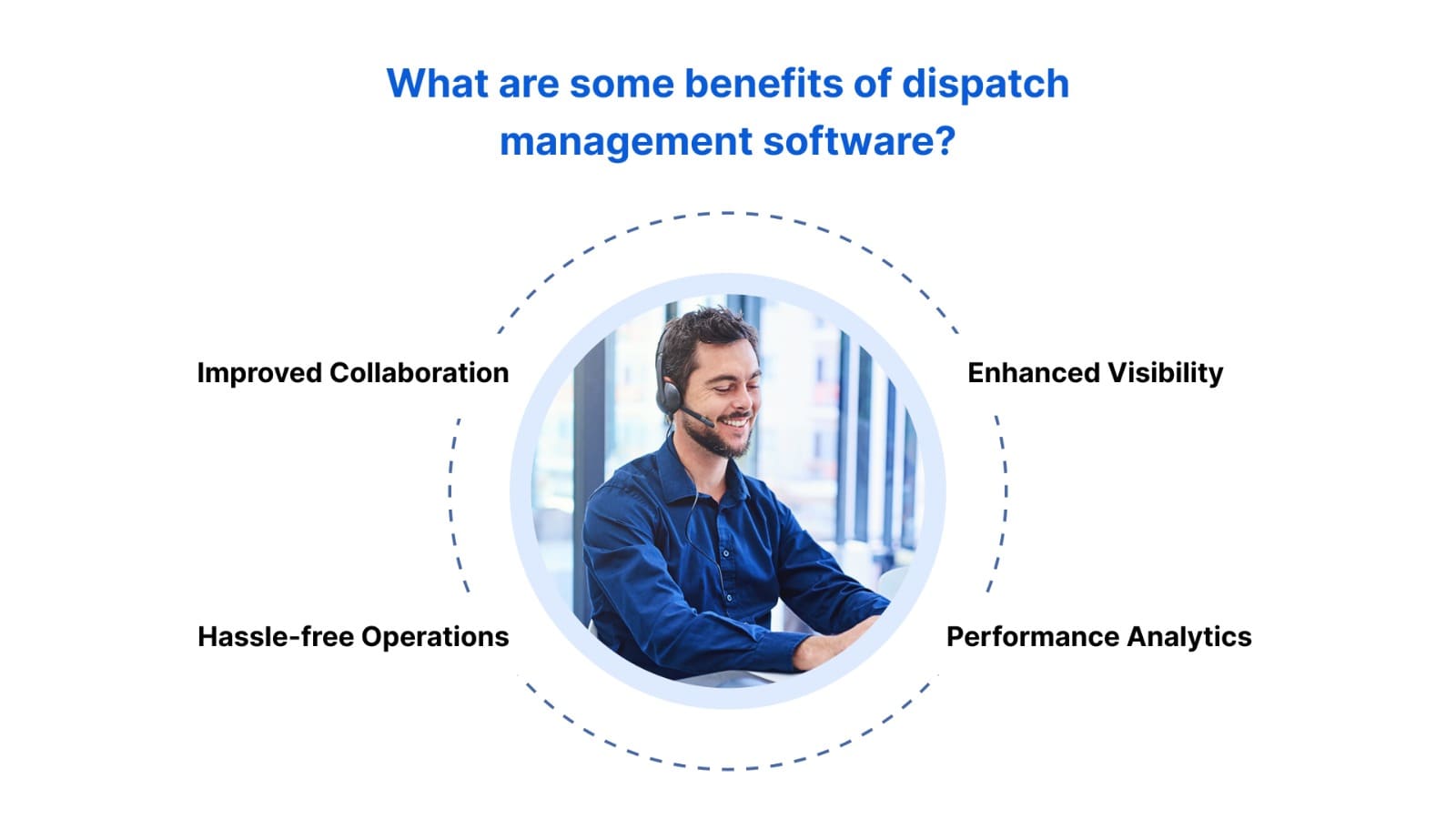Achieving on-time delivery while streamlining operations is the critical differentiator in driving...
Streamline Your Operations with Powerful Dispatch Software
To capitalize on delivery operations, logistic operators need end-to-end visibility and operational control of the entire dispatch process.

Dispatch managers have to make complex decisions during different stages of the fulfillment cycle. The key question is, "How will dispatchers make informed decisions instantly and efficiently while accommodating unexpected shifts in demands?" By crafting an end-to-end supply chain ecosystem where every involved stakeholder is connected and informed with real-time updates.
This includes all processes starting from order capture till the order is delivered to customers’ doorstep. More than 50% of supply chain professionals have decided to invest in digitalization to create frictionless supply chain resilience. Dispatch software enables stakeholders to orchestrate their delivery process execution optimally and effectively.
Before we dive into the value addition of dispatch software, it’s important to understand the end-to-end dispatch process.
Steps in Dispatch Process
 Order capture
Order capture
It involves orders from multiple sources such as manual entries, excel sheets, APIs, or other ERPs. A dispatcher needs to keep a close tab on all upcoming orders from various channels at all times. This is a continuous process that requires constant attention from the dispatcher. The dispatcher must ensure all the inflow of orders is consolidated and forwarded to a centralized dashboard.
Order processing
This step involves arranging incoming orders from disparate sources in one place. Dispatchers spend considerable time in collecting and organizing all information. Further, dispatchers need to batch these orders based on delivery patterns, package dimensions, and other requirements. This leads to increased time to plan and share dispatch sequences with drivers. A centrally managed solution to capture and organize the inflow of orders can ease dispatchers' operations and help reduce manual errors and order processing cycles.
Route Selection
A dispatcher has to generate route plans for multiple deliveries in a day. Based on order flows and delivery commitments, manual route plans are created to accomplish promised SLAs. Despite best efforts in factoring all key considerations, there is still room for error which arises out of the sheer complexity of the problem. This is a complex process as multiple reasons, such as limited tribal knowledge, planning on bulk orders, and last-minute additions or cancellations, can directly affect the planning efficiency.
A dispatch planning software that offers capabilities to generate automated route plans can alleviate the typical struggles of a dispatcher. Complex algorithms supported by route planning solutions determine the most efficient route while considering traffic patterns, road permissions, fuel consumption, and vehicle availability and capacity. Depending on delivery commitments and vehicle capacity, an optimized route plan is created to avoid operational nuances.
Driver Allocation
A dispatcher creates a manual daily roaster and assigns orders to the next available driver based on limited on-ground visibility. This might seem convenient while handling a few deliveries. As the number of deliveries grows, a dispatcher struggles to achieve proper workload allocation while assigning each driver to their respective routes. A recent report published by Forbes suggested that 32% of employee burnout is because of inefficient workload distribution.
Ideally, a dispatcher is expected to ensure balanced workloads and efficient resource utilization while allocating orders to drivers. This can be easily accomplished with the help of a dispatch management solution. The enhanced visibility and automated dispatch operations enable dispatchers to avoid double booking or underutilizing resources. Based on predefined parameters, orders are assigned to the most suitable drivers.
Order out for delivery
When the driver starts their job, they are expected to cover maximum deliveries in one go. A driver typically spends most of their time finding the delivery location. They are either dependent on their tribal knowledge or seeking roadside assistance in getting directions to reach a specific destination. This can be a highly error-prone and time-consuming process.
However, with a dispatch software system coming into picture, selected routes are shared with the allocated driver’s navigation system. It helps in offering turn-by-turn instructions to drivers about the route. This helps in predicting an accurate delivery ETA for all involved stakeholders.
Order Delivered
This marks the last step of the fulfillment process. In many cases, customers expect contactless deliveries as well as several times; the order is delivered to a neighbor as requested by the customer. In addition to these situations, there are certain times when a customer needs proof of a delivered order. This might be challenging for a driver to keep a note of every delivery as they have to deliver several packages in a day.
A driver is asked to collect proof of delivery to avoid any post-delivery conflict and establish proper accountability for the fulfillment process. A dispatch management solution currently supports multiple ways to capture a POD. This serves as a documented acknowledgment from customers and can help resolve future issues.
Challenges in the Dispatching Process
Matching delivery expectations with shifting consumer preferences
Consumer behavior has changed in general and more so within the context of deliveries. It was acceptable to commit a wait time of 5-7 working days, at some point in time. However, that window is shrinking significantly. 90% of customers now consider two or three days as standard delivery time. Among these, 72% of customers are expecting same-day delivery. This makes it challenging for delivery partners to meet exceeding expectations of customers. While businesses recognize the importance of customer experience, establishing a balance between expedited delivery time and dynamic expectations is really hard to accomplish.
Orchestrating fast fulfillment
Businesses are consistently trying to narrow down order capture to order delivery times. A deeper look at previous and current patterns in delivery businesses indicates the sheer effort, investment, and re-alignment of processes required to enable them to withstand competition. Enterprises are continuously evolving to harness the power of technology to expedite their existing processes.
Maintaining profit margins
Fulfillment orchestration requires both high-level as well as granular-level adjustments at different stages. Moving away from traditional methods, logistic processes now involve synchronizing drops to multiple areas while dynamically adjusting customer priorities. To put it in another way, businesses are likely to struggle maximizing their bottom line.

Role of Dispatch Management Software
Businesses are increasingly expanding their delivery operations. Running a successful logistic process requires a combination of advanced practices and technology blend. Here is how dispatch management software can add value to existing operations.
Improved Collaboration
Creating a delivery sequence that enables multiple deliveries on a single route is essential to position the dispatch process successfully. It involves the direct involvement of various stakeholders at different stages of the fulfillment cycle. Dispatch management software allows the stakeholders to quickly and seamlessly exchange information per the requirements. This offers a seamless collaboration between customers, drivers, and dispatchers, enabling transparent and real-time communication, proactive mitigation of chaos and anxiety.
Hassle-free Operations
Dispatch Software eliminates the need for continuous manual intervention in creating and executing a dispatch plan. Based on predefined parameters, the dispatch management solution expedites the dispatch process while making sure all the requirements are accommodated. Further, it enables proactive exception management that saves time and effort, and helps in keeping operations running smoothly.
Enhanced Visibility
There are multiple stages involved in the fulfillment process. Thorough tracking of real-time events enables all parties with the required information. The track and trace feature offers instant visibility of processes at all times and allows timely intervention when and where needed.
Performance Analytics
Dispatch management solution helps uncover the hidden efficiencies of your dispatch process with detailed insights and reports. It helps make informed decisions and identify the operational gaps at the earliest. These reports can be further used to set performance benchmarks.
Conclusion
Key tenets of dispatch software can enhance supply chain visibility and resilience. In fast evolving delivery expectations, businesses need to focus on streamlining and optimizing early-on to ensure orchestration goals are met at every phase.
DispatchOne offers scalable dispatch management solutions designed to empower both enterprises and small businesses by automating their dispatching operations. Through DispatchOne, dispatchers can significantly minimize processing times, achieve centralized visibility, and optimize on-ground operations. Businesses can experience cost reduction, and seamless scalability in their operations while getting the opportunity to expand with effortless and efficient dispatch operations.
Contact us today for a consultation to find out what DispatchOne can do for your delivery business.



